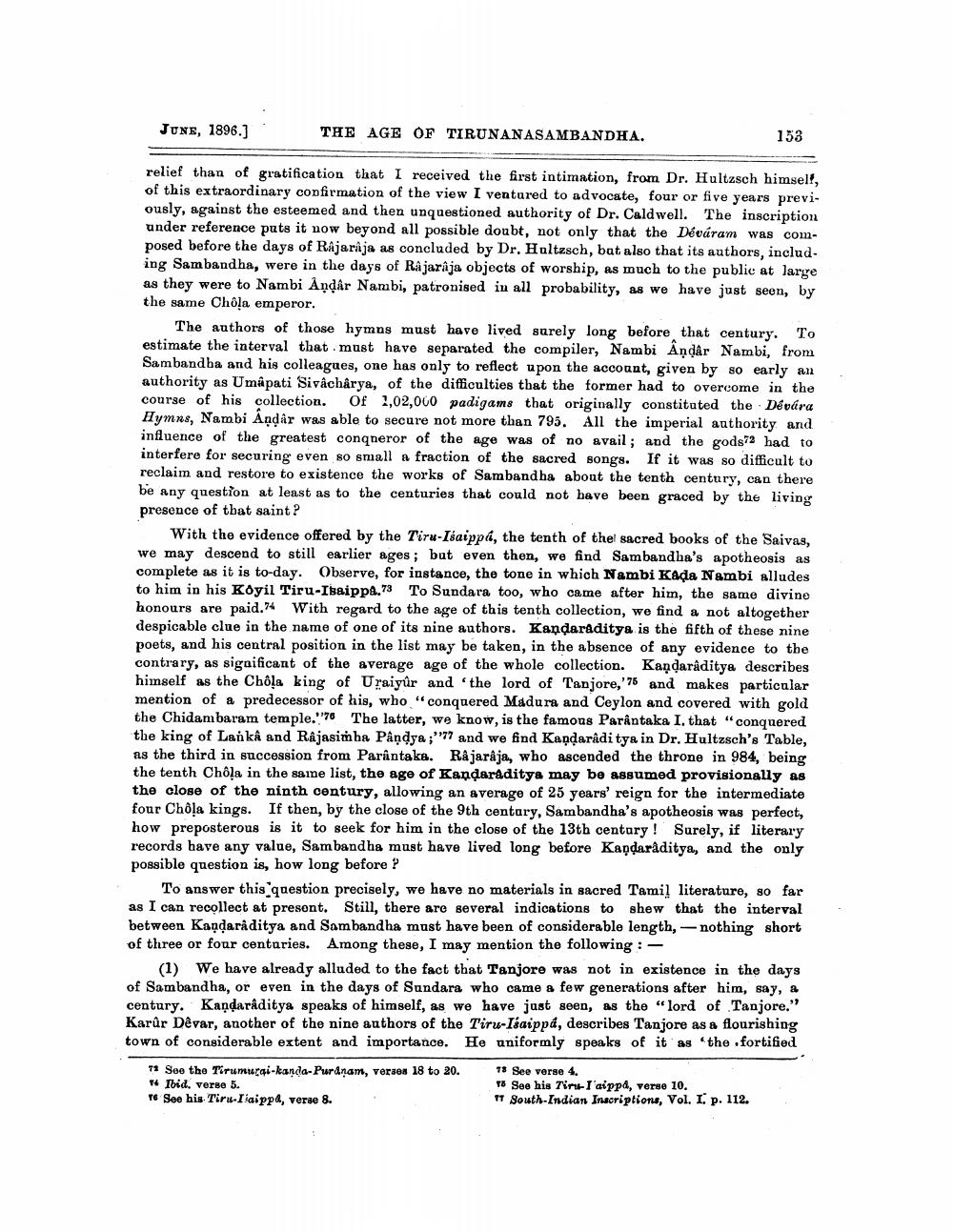________________
JUNE, 1896.]
relief than of gratification that I received the first intimation, from Dr. Hultzsch himself, of this extraordinary confirmation of the view I ventured to advocate, four or five years previously, against the esteemed and then unquestioned authority of Dr. Caldwell. The inscription under reference puts it now beyond all possible doubt, not only that the Déváram was composed before the days of Rajaraja as concluded by Dr. Hultzsch, but also that its authors, including Sambandha, were in the days of Rajaraja objects of worship, as much to the public at large as they were to Nambi Andar Nambi, patronised in all probability, as we have just seen, by the same Chôla emperor.
THE AGE OF TIRUNANASAMBANDHA.
The authors of those hymns must have lived surely long before that century. To estimate the interval that must have separated the compiler, Nambi Andar Nambi, from Sambandha and his colleagues, one has only to reflect upon the account, given by so early an authority as Umapati Sivacharya, of the difficulties that the former had to overcome in the course of his collection. Of 1,02,000 padigams that originally constituted the Dévára Hymns, Nambi Andar was able to secure not more than 795. All the imperial authority and influence of the greatest conqueror of the age was of no avail; and the gods72 had to interfere for securing even so small a fraction of the sacred songs. If it was so difficult to reclaim and restore to existence the works of Sambandha about the tenth century, can there be any question at least as to the centuries that could not have been graced by the living presence of that saint?
153
With the evidence offered by the Tiru-Isaippá, the tenth of the sacred books of the Saivas, we may descend to still earlier ages; but even then, we find Sambandha's apotheosis as complete as it is to-day. Observe, for instance, the tone in which Nambi Kada Nambi alludes to him in his Koyil Tiru-Isaippa.73 To Sundara too, who came after him, the same divine honours are paid. With regard to the age of this tenth collection, we find a not altogether despicable clue in the name of one of its nine authors. Kandaraditya is the fifth of these nine poets, and his central position in the list may be taken, in the absence of any evidence to the contrary, as significant of the average age of the whole collection. Kandarâditya describes himself as the Chôla king of Uraiyûr and the lord of Tanjore,'75 and makes particular mention of a predecessor of his, who "conquered Madura and Ceylon and covered with gold the Chidambaram temple."7 The latter, we know, is the famous Parântaka I. that "conquered the king of Lanka and Râjasimha Pandya ;"77 and we find Kandarâdi tya in Dr. Hultzsch's Table, as the third in succession from Parântaka. Rajaraja, who ascended the throne in 984, being the tenth Chôla in the same list, the age of Kandaraditya may be assumed provisionally as the close of the ninth century, allowing an average of 25 years' reign for the intermediate four Chola kings. If then, by the close of the 9th century, Sambandha's apotheosis was perfect, how preposterous is it to seek for him in the close of the 13th century! Surely, if literary records have any value, Sambandha must have lived long before Kandarâditya, and the only possible question is, how long before?
To answer this question precisely, we have no materials in sacred Tamil literature, so far as I can recollect at present. Still, there are several indications to shew that the interval between Kanḍarâditya and Sambandha must have been of considerable length, nothing short of three or four centuries. Among these, I may mention the following:
(1) We have already alluded to the fact that Tanjore was not in existence in the days of Sambandha, or even in the days of Sundara who came a few generations after him, say, a century. Kandarâditya speaks of himself, as we have just seen, as the "lord of Tanjore." Karûr Dêvar, another of the nine authors of the Tiru-Isaippá, describes Tanjore as a flourishing town of considerable extent and importance. He uniformly speaks of it as the fortified
73 See the Tirumurai-kanda-Puranam, verses 18 to 20. 14 Ibid, verse 5.
Te See his Tiru-Iiaippa, verae 8.
73 See verse 4.
To See his Tiru-I'aippå, verse 10.
TT South-Indian Inscriptions, Vol. I. p. 112.




